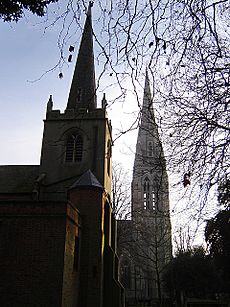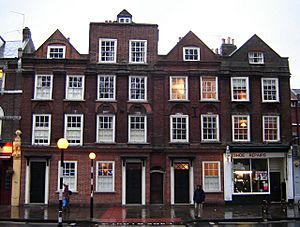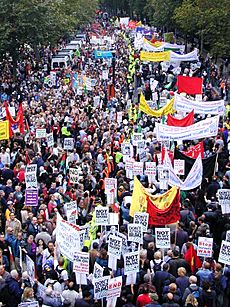Newington Green Unitarian Church facts for kids
Quick facts for kids Newington Green Unitarian Church |
|
|---|---|
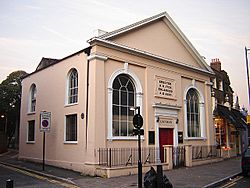 |
|
| 51°33′08″N 0°05′06″W / 51.55217°N 0.08492°W | |
| Location | 39A Newington Green, London N16 9PR |
| Country | England |
| Denomination | General Assembly of Unitarian and Free Christian Churches (British Unitarians) |
| Website | www.new-unity.org |
| History | |
| Founded | 1708 |
Newington Green Unitarian Church is one of England's oldest Unitarian churches. It is located on Newington Green in north London. For over 300 years, this church has been a center for people with forward-thinking ideas about politics and religion. It is also London's oldest Nonconformist place of worship that is still in use today.
The church was started in 1708 by a group of English Dissenters. These were Christians who separated from the Church of England. The church is now run by a group called New Unity.
One of its most famous ministers was Dr. Richard Price. He was a political thinker who supported the French Revolution. A famous member of the church was Mary Wollstonecraft, who is often called the "mother of feminism". She was inspired by Price's sermons to write about rights for both men and women. A mural inside the church honors her.
The building was made bigger in 1860. In 1953, it was officially recognized as a historically important building.
Contents
Why the Church Was Created
After King Charles II returned to the throne in 1660, life became difficult for people who were not part of the Church of England. New laws, called the Clarendon Code, placed many restrictions on them. These people were known as Dissenters or Nonconformists.
The Act of Toleration 1689 later gave Dissenters more freedom. It allowed them to have their own churches and teachers. However, they were still not allowed to hold political office or attend universities like Oxford and Cambridge.
Because of this, many Dissenters moved to areas where they would be more accepted. They often started their own schools, called dissenting academies. These schools were known for being very good. One of these areas was Newington Green, which was then a small village outside London. Many thinkers, teachers, and reformers gathered there.
The Church Building
The first church building was built in 1708. It was a simple, square brick building with a high, tiled roof. Mary Wollstonecraft thought it looked very plain.
In the mid-1800s, the building was made much larger. A gallery was added inside to create more seating. The front of the building was also updated with a new design that included large pillars.
Other religious buildings were nearby. St Matthias' Church was built a short walk away in the 1850s. The Dalston Synagogue was built in 1885 for Jewish people who had moved to the area. The headquarters of the China Inland Mission, a Christian group, was also on the green. Today, St Matthias is still a church, but the synagogue was torn down in the 1970s. The mission building is now used for student housing.
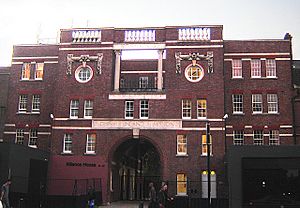
Famous People at the Church
Richard Price: A Voice for Freedom
The most famous minister of the church was Dr. Richard Price. He served from 1758 and made Newington Green a hub for radical thinkers. He believed in liberty and supported the American Revolution.
Many important people visited him at his home on the green. These included American leaders like Benjamin Franklin and Thomas Jefferson. British politicians, thinkers like Adam Smith, and reformers like John Howard also came to see him.
Price's sermons about freedom and politics drew huge crowds to the church. He famously gave a sermon supporting the French Revolution. This started a big debate, known as the Revolution Controversy. His friends, including Thomas Paine and Mary Wollstonecraft, wrote pamphlets to defend his ideas.
Mary Wollstonecraft: The Birth of Feminism

Mary Wollstonecraft, a key figure in the history of women's rights, was deeply influenced by the church. In 1784, she moved her school for girls to Newington Green. Even though she was a member of the Church of England, she attended services at the Unitarian church.
She was inspired by the church's focus on reason and individual thought. Dr. Price became her friend and mentor. He encouraged her writing and introduced her to the publisher Joseph Johnson, who helped start her career.
Inspired by Price's ideas on equality, Wollstonecraft wrote her most famous book, A Vindication of the Rights of Woman. In it, she argued that women should have the same rights and opportunities as men. Because of her connection to the church, it is often called "the birthplace of feminism".
The Barbaulds: Writers and Thinkers
In 1808, Rochemont Barbauld became the minister. His wife, Anna Laetitia Barbauld, was a famous writer of poems, hymns, and children's books. She was also an abolitionist, meaning she worked to end the slave trade.
Anna was a member of the church until she died. A plaque inside the church honors her work for "Humanity, Peace, and Justice." Her brother, Dr. John Aikin, was also a writer and likely attended the church with his family.
The Church in Modern Times
The church building was damaged by bombs during World War II. After the war, the church focused on building connections between people of different races and faiths.
By the late 20th century, the number of members had dropped. The church began working with a nearby Unitarian church, and together they are known as New Unity. A new burst of energy came in the 2000s. The church became active in social causes, such as protesting the Iraq War.
A major renovation of the building was completed in 2020 with help from the National Lottery Heritage Fund. Today, the church describes itself as a place that welcomes everyone. It supports equality for all people and believes everyone has the right to think for themselves.
The Richard Price Memorial Lecture
The church holds a special lecture every year to honor Dr. Richard Price. The lecture focuses on important topics like liberty, reason, and ethics. Past speakers have included the writer Will Self and the BBC presenter Evan Davis.
Celebrating History
In 2008, the church celebrated its 300th anniversary. The celebration was called "300 years of dissent," honoring its long history of challenging common ideas.
The next year, it celebrated the 250th birthday of Mary Wollstonecraft. A large banner on the building called it the "birthplace of feminism." Many events were held to remember her life and work.
Today, the church holds weekly services and hosts poetry readings, meditation sessions, and concerts. It continues to be a place for community, thought, and social action.


